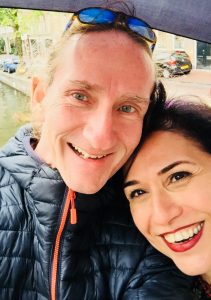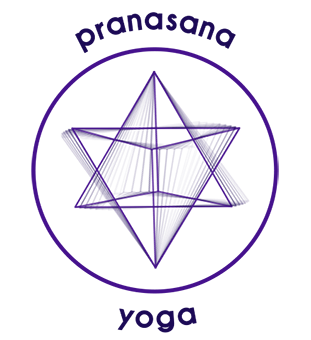
Matt Gluck and Dorna Djenab started Yoga when they were children, learning the techniques of pranayama, relaxation and meditation from their parents, in order to deal with childhood stress. They both became dedicated to yoga many years later, when life provided the insight of the role that it plays in helping us be ourselves, relax and enjoy the journey.
Matt is a British Wheel of Yoga and Life Centre qualified teacher. He has been teaching Raja (Hatha Yoga) full time since 1996 and Chinese martial arts, including Shaolin, Tai Ji (Tai Chi) and Qi Gong since 1988. He has mentored for the Life Centre in Notting Hill Gate, helping Yoga teachers in training. Dorna qualified through the British School of Yoga and has been working with Matt unconditionally, to bring this dream in to waking reality. We both teach our own classes and clients and run workshops and retreats together every few months. Most of our free time is given to sharing and discovering the yogic way together, helping each other on a day by day and moment by moment basis.
We share a gentle, yet intense practice with a focus on present moment awareness, the innate Joy of the Self, breath and relaxation. These synergists facilitate deep insight in to the nature of being, life and our role within it. In yoga we work with people from all walks and stages of life, who come to Yoga for ‘all different sorts of the same reasons’.
We play with the classical asanas (postures), mudras (gestures) and bandhas (locks) of Hatha Yoga, using Vinyasa Krama (Sequencing), to support a simple and clear mirror through which we cultivate awareness. Yogic philosophy understands that despite all the apparent differences that we see around us, everything derives its beingness from one source.
All is one
Our work focuses upon pranayama (breathing methods – providing a view to helping students understand how to develop their own consistent practice) and Asanas - and the relationship between the two and other aspects of yogic life. Other areas of focus include Yin Yoga (gentle deep tissue release), Chi Gung, Nei Gung, Dharana (concentration), Dhyana (meditation) and Yoga Nidra (yogic sleep). We allow people the space that they need, in order to see themselves from within. This awareness is known as Samadhi, the destination in which we see all variables as the ONE awareness or reality.
We teach pranayama, kriyas, meditation and yoga nidra. We also also work with Tai Ji (Tai Chi) and Qi Gong, chanting, dancing, laughter, massage and other means of Vichāra (Self Enquiry). All of these wonderful methods remind us to find our way by looking inward; to see that Space that has always existed before and beyond any story or construct of the mind.
Yoga is a way rather than a practice; it is a view of and alignment with the soul.
Practices incorporate 'methods' from Taoist, Advaita-Vedantic and Buddhist schools as well as Kundalini, Bhakti and Jnana Yoga. Truly, these are all just names and forms. For us, there is only one Yoga; the YOGA OF LOVE’. This is the sole/soul reason that we continue to dance this dance.
We promote safe and simple ‘practice’, with the effect of stilling the mind through a withdrawal of the senses and understanding of the ego. We are flexible in approach, technique, mind and word. The body-mind intelligence always tells the truth. Teachers and students are for inspiring each other; Shiva and Shakti dance.
The truth is seeing our reflection in the appearances that surround us. We realise that yoga emanates from within and that there is nothing to learn from 'out there' that is not already present 'in here'. We all remember yoga, as it reveals itself to us from the centre. Yoga is the art of listening, letting go and undoing. All questions dissolve in the knowledge of the Self (Samadhi or absorption), which comes to us all, in good time.
What is Pranasana?
Pranasana Yoga was received during meditation in 2007 and has been embodied since then, as a way to enjoy and share life with others of like minded heart.
Pranasana is a process. It is the net effect of the combination of ‘Asana’ which is posture, stance or more specifically ‘yogic seat’, with ‘Prana’, life’s essence or pure energy.
Pranasana is therefore the mixture of pranayama, which is energy expansion, with asana, the overall frame within which this energy is contained and directed towards Spirit.
In common life, energy or vitality is lost through the senses. In yogic life, this vitality is turned inward to focus upon its source. This recycling creates a fusion reaction, resulting in the release of increased and refined internal flow. Such improvement in circulation, leads to profound healing and transformation for all layers of our multidimensional Self.
When energy is combined with the intention of a focused heart-mind and the stability of a sound conductor (stable practitioner), one is able one is able to redirect the generative force back inward and upward through the body, in order to achieve the deepest sense of rest. In tandem with this 'Agni Marga' ('fire' path), there also descends the lunar flow of 'nectar from the moon' or 'Amrita Bhava' via the 'Chandra Marga' or 'path of the moon'. This descending heavenly flow helps to release and heal all blockages in the subtle body, thereby further releasing and healing the pranic/chi flow in the physical body. The yoking of these two 'Swaras' (flow/breaths/tones) culminates in 'yoga' ~ the union of the parts into a conscious whole.
Thus understanding awakens that the body and mind are impermanent and the soul-light which illumines it, is the reality which gives birth to our world.
This releases the consciousness from the shackles of earthly life, which are bound by space and time and liberation from the cycle of suffering ensues.
Pranasana Yoga embodies the essence of all traditions, in that the essence of all religions is love. We incorporate 'methods' from Tantric, Taoist and Buddhist schools as well as Raja, Kundalini, Bhakti, Jnana and Mantra Yoga.
If we come to sleep, we are His drowsy ones.
And if we come to wake, we are in His hands.
If we come to weeping, we are His cloud full of raindrops.
And if we come to laughing, we are His lightning in that moment.
If we come to anger and battle, it is the reflection of His wrath.
And if we come to peace and pardon, it is the reflection of His love.
Who are we in this complicated world?
– Rumi –
